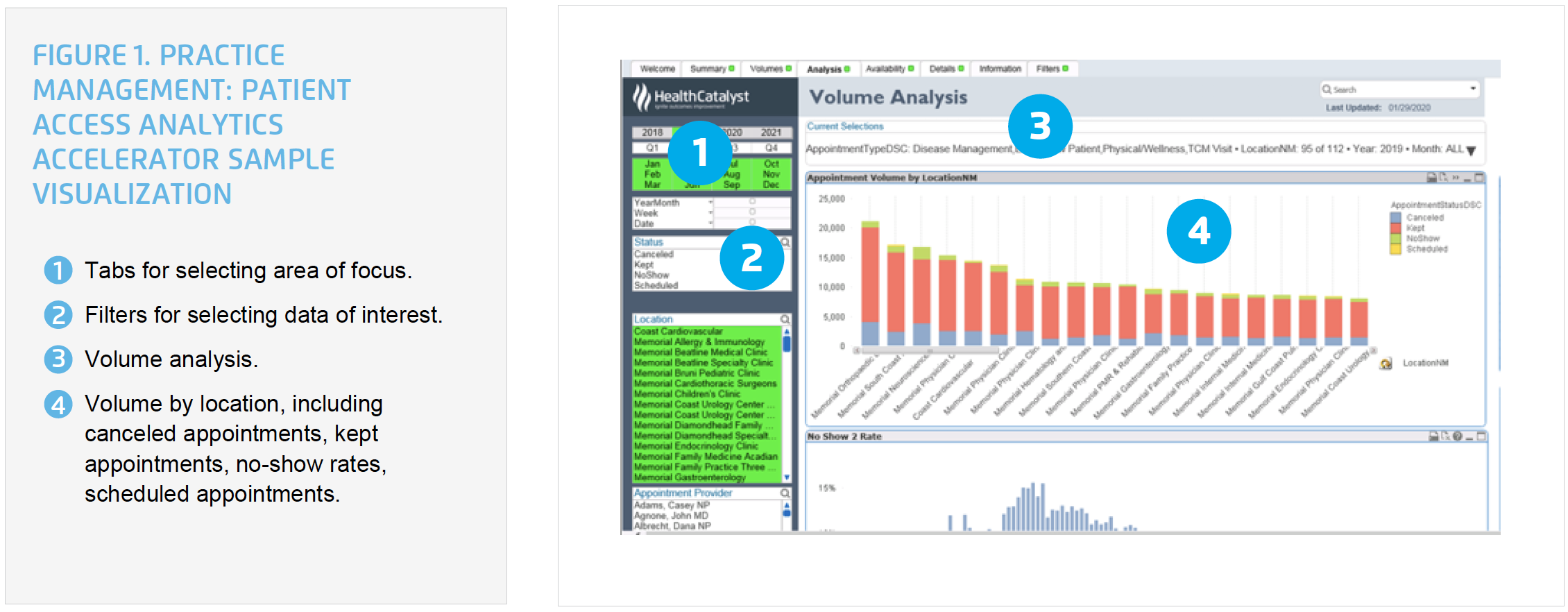Reducing Clinic No-Show Rates Increases Revenue by $1M Annually

- Nearly $804K in additional revenue in just seven months, more than $1M annually, the result of a 28 percent relative reduction in the no-show rate.
Memorial Hospital at Gulfport (Memorial) knew that decreasing clinic no-show rates was an opportunity to increase revenue, eliminate delays in care, and improve care coordination for its patients. With a robust data platform, Memorial leveraged its data and analytics to better understand the reasons behind its high no-show rates. With actionable data, the organization implemented measures to effectively improve its no-show rates and increase revenue.
PATIENT NO-SHOWS COST HOSPITALS BILLIONS
In the U.S., the annual cost to healthcare for “no-shows,” patients who do not show for their scheduled appointment, is estimated at $150 billion. Reducing no-show rates is an opportunity for medical practices to increase revenue, improve access to care, and decrease waste.1
Memorial Hospital at Gulfport (Memorial) is a not-for-profit medical complex in Gulfport, Mississippi, jointly owned by the City of Gulfport and Harrison County. Memorial is one of the most comprehensive health systems in the state, including a state-designated Level II Trauma Center, two outpatient surgery centers, satellite outpatient diagnostic centers, and more than 95 Memorial Physician Clinics (MPC).
LACK OF DATA ROADBLOCK TO DECREASING CLINIC NO-SHOW RATE
Memorial identified that the MPC no-show appointment rate was higher than desired, resulting in a loss of revenue, delays in care, and poor coordination of care for the patients it served.
Several factors contributed to the increased no-show rate, including non-standard work, fragmented communication between the inpatient areas and the outpatient clinics, and a lack of standard practices for managing patient preferences for reminders. Lacking data made it challenging to monitor no-show rates across the organization, limiting the ability to understand the scope of the problem and effectively improve.
Memorial needed a data-driven improvement plan to increase the number of patients who successfully arrived at their scheduled appointment.
ACCURATE DATA REVEALS ROOT CAUSE OF CLINIC NO-SHOW RATE
Memorial convened an improvement team, charging the team with decreasing the clinic no-show rate and improving the number of patients who successfully arrived at their scheduled appointment. The improvement team reviewed the literature to better understand the factors contributing to increased clinic no-show rates but realized before the organization could improve, it needed access to meaningful data that would allow it to understand the root causes of no-shows.
Memorial leveraged the Health Catalyst® Data Operating System (DOS™) platform and a robust suite of analytics applications to more easily access data and analytics. Using the Practice Management: Patient Access Analytics Accelerator, Memorial was able to quickly and easily visualize no-show rates and explore different hypotheses regarding why patients sometimes fail to arrive at their scheduled appointment.
The organization visualized comparisons of its no-show data, including a comparison of no-show rates Monday through Friday and no-show rates stratified by age, payer type, and clinic location (see Figure 1). Memorial was able to compare no-show rates for appointment times before and after 12 p.m. and no-show rates for new patients to the rate for established patients.

The root cause analysis identified four areas of opportunity, and Memorial implemented standard solutions at each of its clinics to address the root causes, including:
- Accurate capture of patient demographics and reminder preferences to ensure patients receive a reminder of their upcoming appointment. Using a script, clinic staff validate the patient’s demographic data at every encounter.
- The completion of standard daily work using an automated daily report. Memorial uses an automated calling system to contact patients scheduled for an appointment a few days prior to their appointment. At the completion of the call, patients have the option to cancel their appointment if they are no longer able to arrive at the scheduled time. Clinic staff receive a cancellation report from the automated calling system, cancel the patient’s appointment so the open slot is available for other patients, and then contact the patient to reschedule, as appropriate.
- Person-to-patient appointment reminders the day prior to the scheduled appointment. Using a standard script, clinic staff contact patients personally, reaching out to them the day prior to their appointment to ensure they are able to arrive as scheduled, offering to reschedule appointments as needed.
- Identification of patients who have been hospitalized and are unable to arrive at their scheduled appointment. Designated clinic staff receive a report of patients who are scheduled to be seen but are currently in the hospital and unable to arrive at their appointment. Clinic staff review the hospitalized patient report at the start of each day and reschedule any hospitalized patients.
Memorial leverages the analytics accelerator to monitor performance and measure the success of the new processes. With the data, Memorial can quickly identify changes/trends that necessitate a change or an intervention. “We now have the data we need to effectively manage our practice management operations with The Practice Management: Patient Access Analytics Accelerator. With the touch of a few buttons, we can get the performance data we need, and can drill down to an individual clinic and provider level. This has allowed us to implement solutions to decrease the no-show rate by 28% and improve revenue by more than $800K.” – Dean Pearson, RN, MSN, CPHQ, LSSBB Director of Quality/Patient Safety
RESULTS
Memorial’s data-driven improvement efforts have successfully reduced its no-show rate, improving access to care and increasing revenue. Results include:
- Nearly $804K in additional revenue in just seven months, more than $1M annually, the result of a 28 percent relative reduction in the no-show rate.
WHAT’S NEXT
Memorial will continue to use data and analytics to ensure it sustains its incredibly low no-show rate and plans to take a data-driven approach to improve other aspects of clinic operations.
REFERENCES
- Stewart. A. (2019). The $150B repercussions of patient no-shows—5 statistics. Becker’s ASC Review.
This website stores data such as cookies to enable essential site functionality, as well as marketing, personalization, and analytics. By remaining on this website you indicate your consent. For more information please visit our Privacy Policy.